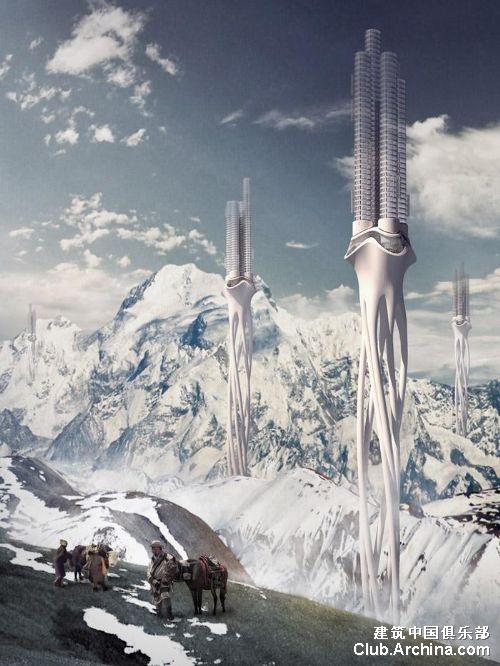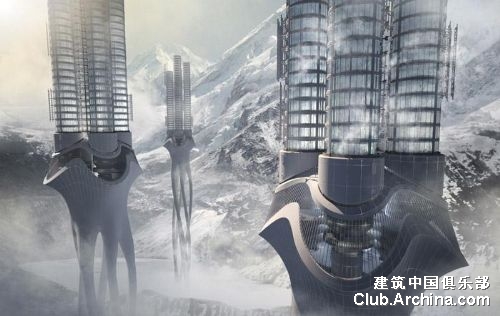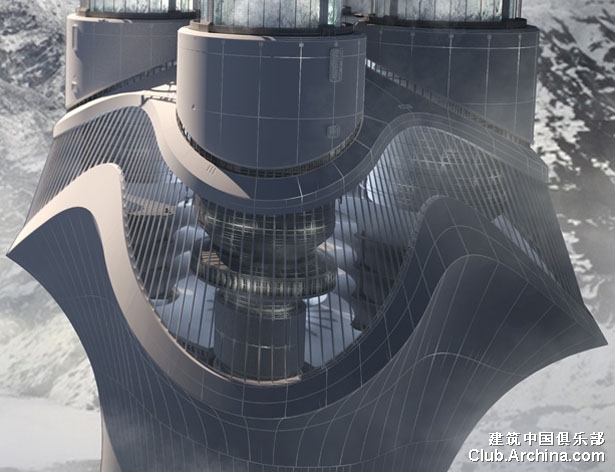哈工大学生作品《喜马拉雅水塔》赢得EVOLO一等奖
摘要: 近日,美国著名建筑杂志《EVOLO》官网公布了2012年EVOLO美国摩天楼设计竞赛获奖名单,本次比赛唯一的一等奖为哈尔滨工业大学师生团队获得。据悉,这是中国建筑师首次突破欧美国家对此项世界顶尖建筑竞赛大奖的垄断, ...
|
近日,美国著名建筑杂志《EVOLO》官网公布了2012年EVOLO美国摩天楼设计竞赛获奖名单,本次比赛唯一的一等奖为哈尔滨工业大学师生团队获得。据悉,这是中国建筑师首次突破欧美国家对此项世界顶尖建筑竞赛大奖的垄断,一举获得纪念奖以外的最高奖项。
作为高水平、国际性设计竞赛,EVOLO美国摩天楼设计竞赛每年都会吸引各国建筑师及著名设计机构参赛。自2006年设立起,该设计竞赛就以摩天楼作为永恒的题目。今年共有95个国家的714个作品参赛,评委团最终选出了3个优胜者和22个特别奖。
本次比赛一等奖获奖作品名为《喜马拉雅水塔》,由哈工大建筑学院四年级学生郑植、赵洪川、宋东白共同设计,建筑系教师陆诗亮副教授辅导完成。该作品创意在于引起人们关注世界范围内的气候变化对高原环境的影响,作品以其新颖的设计理念获得了评委团的一致认可。设计者利用摩天楼技术,根据季节及气候变化服务蓄水,并帮助调节水资源合理利用。创造性地提出通过收集水净化后,冻结成冰,根据气候情况,使其在冰与水间合理转化,以便存储供将来使用。
喜马拉雅的水塔The himalayan water tower,2012年eVolo摩天楼大赛头等奖,由中国的哈工大的学生团队设计。设计者:郑智、赵洪川、宋东白 (谐音) Designers : Zhi Zheng, Hongchuan Zhao, Dongbai Song 最早的有建筑意义的建筑,约出现在一万一千年前,而如今每一次evolo所决出的摩天大楼却在渐渐地消除建筑意义,而只能让人说它所指的摩天楼代表了更广义的建筑。 这种更广义的建筑,应是在代表人类共同生存愿景的前提下,与经济、环境、政治、城市发生直接或间接影响关系的一种具有一定尺度的功能装置。
其头奖作品“喜马拉雅的水塔”(the himalayan water tower)正是这种以保护生态环境为目的的具大技术装置,其上层储冰根部蓄水,以使在全球变暖山雪融化的情况下,保持生态的相对平衡,并解决区域居民的生存问题,同时向全球发出生态破坏的警示。
从evolo竞赛的以往作品来看,其主题自发性的成为了:人类求生心切,让建筑成为未来人类逃生的装置。希望这不是更广义的建筑的最终的下场。 原文: Himalaya Water Tower concept is the winner 2012 Skyscraper competition held by eVolo Magazine. Situated in the high Himalayan mountain range, this skyscraper is responsible to store water and help regulate its distribution to the land below as the mountains natural supplies dry up. Based on Wikipedia, The Himalayan range encompasses about 15,000 glaciers, which store about 12,000 km3 of world’s freshwater. Due to climate change, these massive ice sheets are melting faster than ever that put villages and cities even the continent of Asia at risk of flooding. Himalaya Water Tower structure has been designed to enable mass production or replication. It will collect water in the rainy season, purify it, freeze it into ice and store it for future use. This tower can also schedule its water distribution to meet the needs of residents below while at the same time save water for our future generations. Designers : Zhi Zheng, Hongchuan Zhao, Dongbai Song The lower part of the Himalaya Water tower is comprised of six stem-like pipes that curve and wind together and collect and store water. Like the stem of a plant, these pipes grow strong as they absorb their maximum water capacity. In each of the six stems, a core tube is flanked by levels and levels of cells, which hold the water. The upper part of the building – the part that is visible above the snow line – is used for frozen storage. Four massive cores support steel cylindrical frames that, like the stems below, hold levels that radiate out, creating four steel tubes filled with ice. In between the two sections are mechanical systems that help freeze the water when the climatic conditions aren’t able to do so, purify the water and regulate the distribution of water and ice throughout the structure. At the bottom of the Himalaya Water tower structure, surrounding the six intertwined water tubes is a transport system that regulates fresh water distribution to the towns and cities below. The curving channels connect the mountains to the villages, and are also hold within them a railway for the transport of people and goods. |
已有 0 人参与
会员评论







